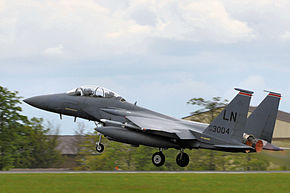494th Fighter Squadron
| 494th Fighter Squadron | |
|---|---|

Squadron F-15 Eagle taking off
|
|
| Active | 1941–1945; 1952–present |
| Country |
|
| Branch |
|
| Type | Fighter |
| Part of |
United States Air Forces in Europe 3d Air Force 48th Fighter Wing 48th Operations Group |
| Garrison/HQ | RAF Lakenheath |
| Nickname(s) | Panthers |
| Decorations |
Distinguished Unit Citation Air Force Outstanding Unit Award Navy Meritorious Unit Commendation Belgian Fourragère |
| Commanders | |
| Current commander |
Lt Col Philip Principi (as of 31 December 2013) |
| Insignia | |
| 494th Fighter Squadron emblem (Approved 6 December 1963) |  |
| 57th Bombardment Squadron emblem (Approved 22 August 1942) |  |
The 494th Fighter Squadron (494 FS) is part of the 48th Fighter Wing at RAF Lakenheath, England.
The 494th FS is a combat-ready F-15E Strike Eagle squadron capable of executing strategic attack, interdiction, and counter air missions in support of United States Air Forces in Europe, United States European Command, and NATO operations. It employs the full array of air superiority and surface attack munitions to include the most advanced precision-guided weapons in the USAF inventory. The squadron is capable of deploying to any theater of operations in the world.
Activated as a Southeastern Air District Army Air Corps training squadron, equipped with a variety of second-line aircraft, both single and twin engine, preparing its pilots and maintenance crews for eventual combat. After the Pearl Harbor Attack, the squadron flew antisubmarine patrols from, March–April 1942. Resumed aircrew training, many of the group's members went on to serve in squadrons stationed in Europe and the Pacific theaters.
Eventually coming under the AAF III Fighter Command in 1944, trained replacement pilots with P-47 Thunderbolts, Converted in January 1944 to an operational fighter squadron with the end of RTU training. Deployed to the European Theater of Operations (ETO), being assigned to the IX Fighter Command in England, March 1944.
Almost immediately after their arrival, the squadron began a rigorous training program, flying dive-bombing, glide bombing, night flying, low-level navigation, smoke laying, reconnaissance, and patrol convoy sorties. Over the next two months, the number of sorties steadily increased and the squadron flew its first combat mission on 20 April 1944—an uneventful fighter sweep of the occupied French coast.
...
Wikipedia
